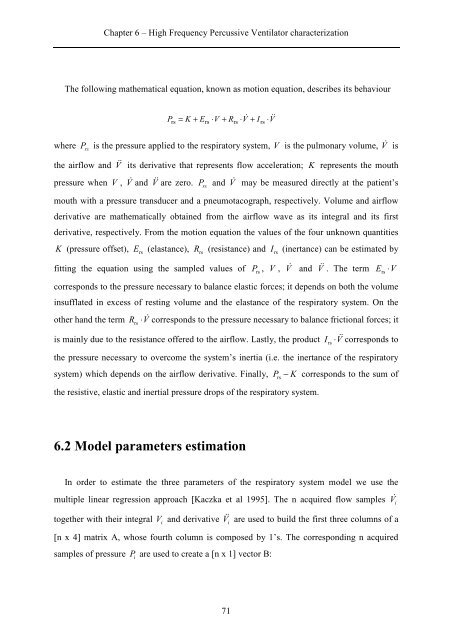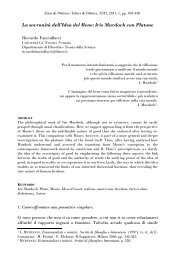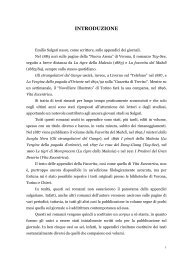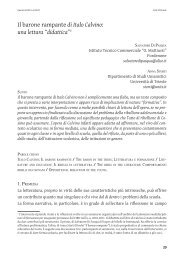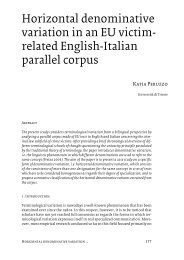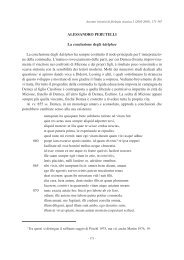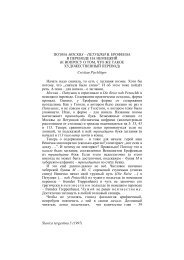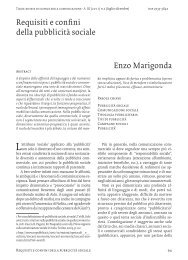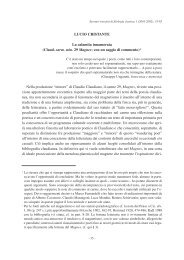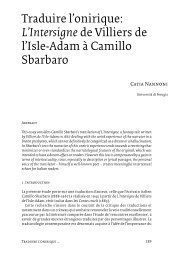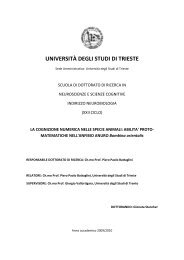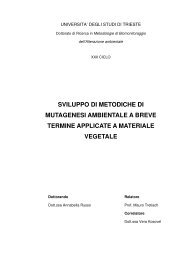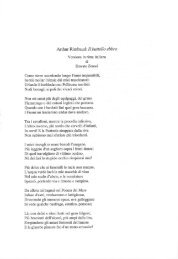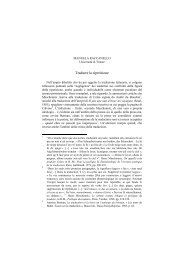UNIVERSITÀ DEGLI STUDI DI TRIESTE - OpenstarTs - Università ...
UNIVERSITÀ DEGLI STUDI DI TRIESTE - OpenstarTs - Università ...
UNIVERSITÀ DEGLI STUDI DI TRIESTE - OpenstarTs - Università ...
Create successful ePaper yourself
Turn your PDF publications into a flip-book with our unique Google optimized e-Paper software.
Chapter 6 – High Frequency Percussive Ventilator characterization<br />
The following mathematical equation, known as motion equation, describes its behaviour<br />
P<br />
rs<br />
= K + E ⋅V<br />
+ R ⋅V&<br />
rs rs + Irs<br />
⋅V&<br />
where P<br />
rs<br />
is the pressure applied to the respiratory system, V is the pulmonary volume, V & is<br />
the airflow and V & its derivative that represents flow acceleration; K represents the mouth<br />
pressure when V , V & and V & are zero.<br />
P<br />
rs<br />
and V & may be measured directly at the patient’s<br />
mouth with a pressure transducer and a pneumotacograph, respectively. Volume and airflow<br />
derivative are mathematically obtained from the airflow wave as its integral and its first<br />
derivative, respectively. From the motion equation the values of the four unknown quantities<br />
K (pressure offset),<br />
E<br />
rs<br />
(elastance),<br />
fitting the equation using the sampled values of<br />
R<br />
rs<br />
(resistance) and I<br />
rs<br />
(inertance) can be estimated by<br />
P<br />
rs<br />
, V , V & and V & . The term<br />
Ers<br />
⋅V<br />
corresponds to the pressure necessary to balance elastic forces; it depends on both the volume<br />
insufflated in excess of resting volume and the elastance of the respiratory system. On the<br />
other hand the term<br />
R<br />
rs<br />
⋅V&<br />
corresponds to the pressure necessary to balance frictional forces; it<br />
is mainly due to the resistance offered to the airflow. Lastly, the product<br />
I<br />
rs<br />
⋅V&<br />
corresponds to<br />
the pressure necessary to overcome the system’s inertia (i.e. the inertance of the respiratory<br />
system) which depends on the airflow derivative. Finally,<br />
the resistive, elastic and inertial pressure drops of the respiratory system.<br />
Prs − K corresponds to the sum of<br />
6.2 Model parameters estimation<br />
In order to estimate the three parameters of the respiratory system model we use the<br />
multiple linear regression approach [Kaczka et al 1995]. The n acquired flow samples<br />
together with their integral V<br />
i<br />
and derivative V & i<br />
are used to build the first three columns of a<br />
[n x 4] matrix A, whose fourth column is composed by 1’s. The corresponding n acquired<br />
samples of pressure P<br />
i<br />
are used to create a [n x 1] vector B:<br />
V &<br />
i<br />
71


